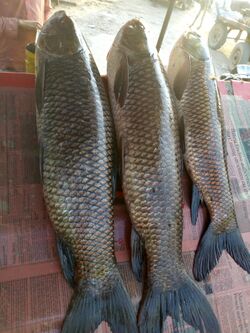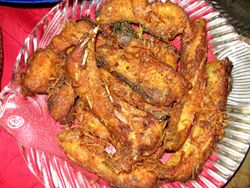Biology:Rohu
| Rohu | |
|---|---|

| |
| Scientific classification | |
| Script error: No such module "Taxobox ranks".: | Animalia |
| Script error: No such module "Taxobox ranks".: | Chordata |
| Script error: No such module "Taxobox ranks".: | Actinopterygii |
| Script error: No such module "Taxobox ranks".: | Cypriniformes |
| Script error: No such module "Taxobox ranks".: | Cyprinidae |
| Script error: No such module "Taxobox ranks".: | Labeoninae |
| Script error: No such module "Taxobox ranks".: | Labeo |
| Script error: No such module "Taxobox ranks".: | <div style="display:inline" class="script error: no such module "taxobox ranks".">L. rohita |
| Binomial name | |
| Labeo rohita F. Hamilton, 1822
| |
| Synonyms | |
| |


The rohu, rui, ruhi or roho labeo (Labeo rohita) is a species of fish of the carp family, found in rivers in South Asia. It is a large omnivore and extensively used in aquaculture.
Description
The rohu is a large, silver-colored fish of typical cyprinid shape, with a conspicuously arched head. Adults can reach a maximum weight of 45 kg (99 lb) and maximum length of 2 m (6.6 ft),[2] but average around 1⁄2 m (1.6 ft).[citation needed]
Distribution and habitat
The rohu occurs in rivers throughout much of northern and central and eastern India ,[3] Pakistan , Vietnam, Bangladesh, Nepal and Myanmar, and has been introduced into some of the rivers of Peninsular India and Sri Lanka.[1][2]
Ecology
The species is an omnivore with specific food preferences at different life stages. During the early stages of its lifecycle, it eats mainly zooplankton, but as it grows, it eats more and more phytoplankton, and as a juvenile or adult is a herbivorous column feeder, eating mainly phytoplankton and submerged vegetation. It has modified, thin hair-like gill rakers, suggesting that it feeds by sieving the water.[4]
Rohu reach sexual maturity between two and five years of age. They generally spawn during the monsoon season, keeping to the middle of flooded rivers above tidal reach. The spawning season of rohu generally coincides with the southwest monsoon. Spawn may be collected from rivers and reared in tanks and lakes.[2]
Aquaculture
The rohu is an important aquacultured freshwater species in South Asia.[5] When cultured, it does not breed in lake ecosystems, so induced spawning is necessary.[6][7] The rohu is also prized as a game fish.[1]
Preparation as food
Rohu is very commonly eaten in Bangladesh, Nepal, Pakistan and the India n states of Tripura, Nagaland, Bihar, Odisha, Assam, West Bengal, Andhra Pradesh, Tamilnadu and Uttar Pradesh.[3] A recipe for fried Rohu fish is mentioned in Manasollasa, a 12th-century Sanskrit encyclopedia compiled by Someshvara III, who ruled from present-day Karnataka. In this recipe, the fish is marinated in asafoetida and salt after being skinned. It is then dipped in turmeric mixed in water before being fried.[8]
Rohu caught in Mithila are known as Mithila Rohu Machh (Maithili: मिथिला रोहु माछ) and considered tastier than the Rohu varieties found in the coastal areas. The Bihar State government is currently making efforts to establish a List of geographical indications in India (GI) tag for the fish.[9][10]
Nutrition
Rohu is rich in Omega 3 fatty acids, Vitamin A, Vitamin B and Vitamin C.[11] It is also rich in Vitamin D, a Vitamin which is present only in a few foods and consumption of the fish will prevent Osteoporosis, a Vitamin D deficiency disease.[12]
References
- ↑ 1.0 1.1 1.2 Dahanukar, N. (2010). "Labeo rohita". IUCN Red List of Threatened Species 2010: e.T166619A6248771. doi:10.2305/IUCN.UK.2010-4.RLTS.T166619A6248771.en. https://www.iucnredlist.org/species/166619/6248771. Retrieved 19 November 2021.
- ↑ 2.0 2.1 2.2 Froese, Rainer and Pauly, Daniel, eds. (2013). "Labeo rohita" in FishBase. May 2013 version.
- ↑ 3.0 3.1 "Rohu Fish Farming Information Guide - Agri Farming". 26 August 2015. http://www.agrifarming.in/rohu-fish-farming/.
- ↑ "Composite fish culture". http://www.keralaagriculture.gov.in/htmle/bankableagriprojects/fish%5Cfishculture.htm.
- ↑ "FAO Fisheries & Aquaculture Labeo rohita". http://www.fao.org/fishery/culturedspecies/Labeo_rohita/en.
- ↑ de Graaf, G.; Latif, A. (2002). "Development of freshwater fish farming and poverty alleviation - A case study from Bangladesh". Aquaculture Asia 7 (2): 5. http://www.nefisco.org/downloads/DevelopmentOfFreshwaterFishFarming.pdf.
- ↑ Nandeesha, M.C. (1990). "Induced spawning of Indian major carps through a single application of Ovaprim-C.". Asian Fisheries Society. http://www.nickparkerllc.com/index_pdf/pubs/parker/33induced.htm.
- ↑ K.T. Achaya (2003). The Story of Our Food. Universities Press. p. 85. ISBN 978-81-7371-293-7. https://books.google.com/books?id=bk9RHRCqZOkC&pg=PA85.
- ↑ "Mithila's 'Rohu'" (in en). https://www.drishtiias.com/state-pcs-current-affairs/mithila-s-rohu.
- ↑ "Bihar govt to approach Centre over GI tag for Mithila's Rohu fish" (in en). https://www.moneycontrol.com/news/trends/current-affairs-trends/bihar-govt-to-approach-centre-over-gi-tag-for-mithilas-rohu-fish-8325231.html.
- ↑ "10 healthiest Indian fish varieties and why you must have them". https://m.timesofindia.com/life-style/food-news/10-healthiest-indian-fish-varieties-and-why-you-must-have-them/photostory/70315973.cms.
- ↑ "World Osteoporosis Day: Things women can do to make their bones stronger". https://www.financialexpress.com/healthcare/wellness/world-osteoporosis-day-things-women-can-do-to-make-their-bones-stronger/2730234/.
Wikidata ☰ Q311727 entry
 |

